Punjab State Board PSEB 6th Class Maths Book Solutions Chapter 12 Perimeter and Area Ex 12.2 Textbook Exercise Questions and Answers.
PSEB Solutions for Class 6 Maths Chapter 12 Perimeter and Area Ex 12.2
1. Find the approximate area of each of the following figures by countaing the number of squares – complete, more than half and exactly half.
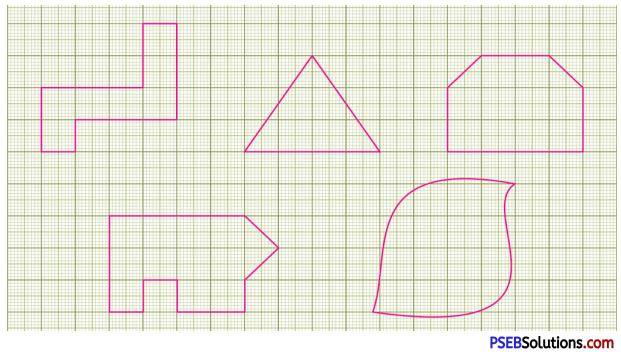
Solution:
(i) Number of complete squares m = 7
Here we do not have any half square or more than half.
∴ n = 0, p = 0
∴ Area of plane figure = m + n + \(\frac {1}{2}\)p
= 7 + 0 + 0
= 7 sq. units
(ii) Number of complete squares m = 2
Number of more than half squares n = 4
Number of half squares p = 0
∴ Area of plane figure = m + n + \(\frac {1}{2}\)p
= 4 + 2 + 0
= 6 sq. units.
(iii) Number of complete squares m = 10
Number of more than half squares n = 0
Number of exactly half squares p = 2
∴ Area of plane figure = m + n + \(\frac {1}{2}\)p
= (10 + 0 + \(\frac {1}{2}\) × 2) sq. units
= (10 + 1) sq. units
= 11 sq. units
(iv) Number of complete squares m = 11
Number of more than half squares n = 0
Number of exactly half squares p = 2
∴ Area of plane figure = m + n + \(\frac {1}{2}\)p
= 11 + 0 + \(\frac {1}{2}\) × 2
= 11 + 1 = 12 sq. units
(v) Number of complete squares m = 10
Number of more than half squares n = 3
Number of exactly half squares p = 0
∴ Area of plane figure = m + n + \(\frac {1}{2}\)p
= 10 + 3 + 0
= 13 sq. units
![]()
2. Find the area of rectangle whose:
Question (i)
length = 12 cm, breadth = 16 cm
Solution:
Length of rectangle = 12 cm
and Breadth of rectangle = 16 cm.
∴ Area of rectangle = Length × Breadth
= 12 cm × 16 cm
= 192 sq. cm
Question (ii)
length = 25 m, breadth = 18 m
Solution:
Length of rectangle = 25 m
and Breadth of rectangle = 18 m
∴ Area of rectangle = Length × Breadth
= 25 m × 18 m
= 450 sq. m
Question (iii)
length = 2.7 m, breadth = 45 cm
Solution:
Length of rectangle = 2.7 m = 270 cm
and Breadth of rectangle = 45 cm
∴ Area of rectangle = Length × Breadth
= 270 cm × 45 cm
= 12150 sq. cm
Question (iv)
length 4.2 cm, breadth = 1.5 cm
Solution:
Length of rectangle = 4.2 cm
and Breadth of rectangle = 1.5 cm
∴ Area of rectangle = Length × Breadth
= 4.2 cm × 1.5 cm
= 6.3 sq. cm
Question (v)
length = 3.8 mm, breadth = 4 mm.
Solution:
Length of rectangle = 3.8 mm
and Breadth of rectangle = 4 mm
∴ Area of rectangle = Length × Breadth
= 3.8 mm × 4 mm
= 15.2 sq. mm
![]()
3. Find the area of the square with side:
Question (i)
19 cm
Solution:
Side of the square = 19 cm
∴ Area of the square = side × side
= 19 cm × 19 cm = 361 sq. cm.
Question (ii)
24 mm
Solution:
Side of square = 24 mm
∴ Area of square = side × side
= 24 mm × 24 mm
= 576 sq. mm
Question (iii)
3.5 cm
Solution:
Side of the square = 3.5 cm
Area of square = side × side
= 3.5 cm × 3.5 cm
= 12.25 sq. cm
Question (iv)
2.6 cm
Solution:
Side of the square = 2.6 cm
Area of square = side × side
= 2.6 cm × 2.6 cm
= 6.76 sq. cm
![]()
Question (v)
8.2 cm.
Solution:
Side of the square = 8.2 cm
Area of the square = side × side
= 8.2 cm × 8.2 cm
= 67.24 sq. cm.
4. The area of a rectangle is 216 sq. cm and its length is 12 cm. Find its breadth.
Solution:
The area of the rectangle = 216 sq. cm.
Length of the rectangle = 12 cm
Breadth of the rectangle = \(\frac{\text { Area }}{\text { Length }}\)
= \(\frac {216}{12}\) cm
= 18 cm.
5. The area of a rectangle is 225 sq. m and its breadth is 9 in. Find its length.
Solution:
The area of the rectangle = 225 sq. m
and Breadth of the rectangle = 9 m
∴ Length of the rectangle = \(\frac{\text { Area }}{\text { Breadth }}\)
= \(\frac {225}{9}\) m
= 25 m
6. The length and breadth of a ground are 32 m and 24 m. Find the cost of levelling the ground at the rate of ₹ 3 per sq. m.
Solution:
Length of ground = 32 m
and Breadth of ground = 24 m
Area of the ground = Length × Breadth
= 32 m × 24 m
= 768 sq. m.
Levelling cost of 1 sq. m = ₹ 3
Levelling cost of 768 sq. m = ₹ 3 × 768
= ₹ 2304
![]()
7. Find the perimeter of a rectangle whose area is 324 sq. cm and its one side is 36 cm.
Solution:
Area of rectangle = 324 sq. cm
One side of rectangle = 36 cm
∴ Other side of rectangle = \(\frac{\text { Area }}{\text { One side }}\)
= \(\frac {324}{36}\) = 9 cm
Perimeter of rectangle
= 2 × (1st side + 2nd side)
= 2 × (36 + 9) cm
= 2 × 45 cm
= 90 cm
8. The perimeter of a square field is 100 m. Find its area.
Solution:
The perimeter of square field = 100 m
∴ 4 × side of square = 100 m
∴ Side of a square = \(\frac {100}{4}\) = 25 m
Hence area of square field = side × side
= 25 m × 25 m
= 625 sq. m.
9. Area of a rectangle of length 20 cm is 340 sq. cm. Find its perimeter.
Solution:
Area of rectangle = 340 sq. cm
and Length of rectangle = 20 cm
Breadth of rectangle = \(\frac{\text { Area }}{\text { Length }}\)
= \(\frac {340}{20}\) cm = 17 cm
Perimeter of rectangle
= 2 × (Length + Breadth)
= 2 × (20 + 17) cm
= 2 × 37 cm
= 74 cm
![]()
10. A marble tile measure 15 cm × 20 cm. How many tiles will be required to cover a wall of size 4 m × 6 m?
Solution:
Area of the wall = 4 m × 6 m
= 400 cm × 600 cm
= 240000 sq. cm
Area of a marble tile = 15 cm × 20 cm
= 300 sq. cm
Number of tiles required to cover wall
= \(\frac{\text { Area of wall }}{\text { Area of tile }}=\frac{240000}{300}\) = 800
Hence number of tiles required to cover wall = 800
11. Find the cost of levelling the square field of side 75 m at rate of ₹ 5 per square metre.
Solution:
Side of the square field = 75 m
Area of square field = side × side
= 75 m × 75 m
= 5625 sq. m
Cost of levelling 1 sq. m = ₹ 5
Cost of levelling 5625 sq. m = ₹ 5 × 5625
= ₹ 28125
12. How many stamps of size 2 cm × 1.5 cm can be pasted on a sheet of paper of size 6 cm × 12 cm?
Solution:
Area of the sheet of paper
= 6 cm × 12 cm = 72 sq. cm
Area of one stamp = 2 cm × 1.5 cm = 3 sq cm
Number of stamps pasted on sheet of paper
= \(=\frac{\text { Area of paper sheet }}{\text { Area of stamp }}=\frac{72}{3}\) = 24.
![]()
13.
Question (i)
What will happen to the area of a square if its side is trebled (tripled)?
Solution:
Let side of the square = x cm
∴ Area of the square = (x × x) sq. m
Now, if the side is trebled, then side of new square = 3x cm
∴ Area of the new square
= [(3x) × (3x)] sq. m
= (3 × 3 × x × x) sq. m
= 9 (x × x) sq. cm
= 9 × (Area of original square)
∴ If side is trebled, then area becomes 9 times of original area.
Question (ii)
What will happen to the area of a rectangle if its length is halved and breadth is doubled?
Solution:
l cm and b cm be the length and breadth of the rectangle respectively.
∴ Area of rectangle = l × b
Now, If its length is halved and breadth is doubled.
∴ New length = \(\frac {1}{2}\) l
and new breadth = 2b
Thus area of new rectangle = length × breadth
= \(\frac {1}{2}\) × l × 2b
= \(\frac {1}{2}\) × 2 × (l × b)
= (l × b) = original area
Area will remain the same.
Question (iii)
What will happen to the area of a square if its side is halved?
Solution:
Let side of the square = x cm
∴ Area of the square = (x × x) sq. cm
Now, if side is halved, then
side of new square = \(\frac {1}{2}\)x cm
∴ Area of the new square sq.cm
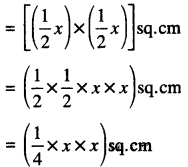
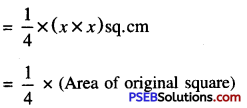
Hence, if side is halved, then the area becomes one-fourth times original area.
![]()
14. Find the area of the following figures by splitting it into rectangles and squares:
Question (i)
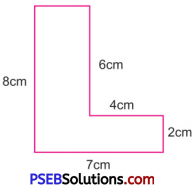
Solution:
The given figure can be divided into 2 parts
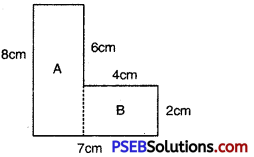
Rectangle A of size 8 cm × 3 cm
Rectangle B of size 4 cm × 2 cm
∴ Area of rectangle A
= 8 cm × 3 cm = 24 sq. cm
and Area of rectangle B
= 4 cm × 2 cm
= 8 sq. cm
⇒ Total area of the figure
= 24 sq. cm + 8 sq. cm
= 32 sq. cm
Question (ii)
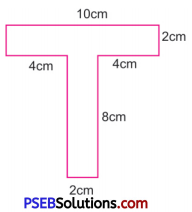
Solution:
The given figure can be divided into 2 parts
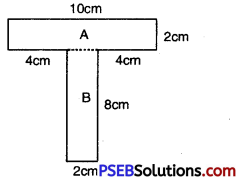
Rectangle A of size 10 cm × 2 cm
Rectangle B of size 8 cm × 2 cm
∴ Area of rectangle A
= 10 cm × 2 cm = 20 sq. cm
and Area of rectangle B
= 8 cm × 2 cm = 16 sq. cm
Total Area of the figure
= (20 + 16) sq. cm = 36 sq. cm
![]()
Question (iii)
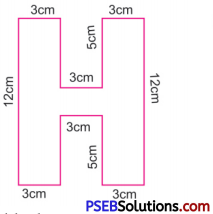
Solution:
The given figure can be divided into 3 parts
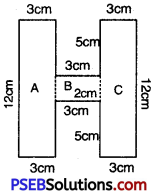
Rectangle A of size 12 cm × 3 cm
Rectangle B of size 3 cm × 2 cm
Rectangle of size 12 cm × 3 cm
Area of rectangle A
= 12 cm × 3 cm = 36 sq. Cm
Area of rectangle B
= 3 cm × 2 cm = 6 sq. cm
Area of rectangle C
= 12 cm × 3 cm = 36 sq. cm
Total area of the figures
= (36 + 6 + 36) sq. cm
= 78 sq. cm
Question (iv)
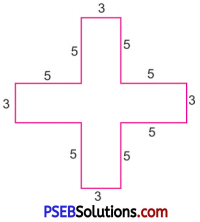
Solution:
The given figure can be divided into 3 parts
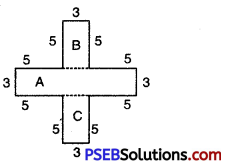
Rectangle A of size 13 × 3 units
Rectangle B of size 5 × 3 units
Rectangle C of size 5 × 3
Area of rectangle A
= 13 × 3 = 39 sq. units
Area of rectangle B
= 5 × 3 = 15 sq. units
Area of rectangle C
= 5 × 3 = 15 sq. units
Hence total area of the figure
= (39 + 15 + 15) sq. units
= 69 sq. units Ans.
15. Fill in the blanks:
Question (i)
1 square metre = ……….. sq. cm.
Solution:
10000
Question (ii)
1 square cm = ………. sq. mm.
Solution:
100
![]()
Question (iii)
Area of Rectangle = …………. × ……………
Solution:
length, breadth
Question (iv)
Length = ………….. ÷ breadth.
Solution:
Area
Question (v)
Area of square = …………. × ……………
Solution:
side × side.
